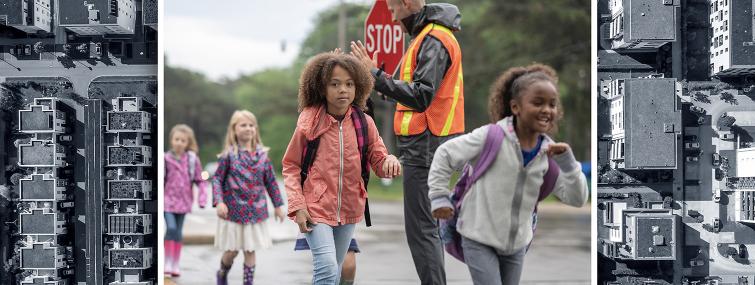Integration and Equity 2.0: New and Reinvigorated Approaches to School Integration
Schools in the United States are more segregated today than they were 30 years ago. In this September 2023 landmark essay series, the AIR Equity Initiative weaves a tapestry of diverse voices, delivering insights and evidence for all who aspire to build a better and more equitable future for our nation’s young people.
Offering ideas and recommendations from across the spectrum of research, policy, and practice—and intersecting fields including health, housing, transportation, and public safety—authors challenge common deficit-based narratives and propel the urgent conversation on educational equity.
WELCOME LETTER
A Call for Integration and Educational Equity
Rashawn Ray, AIR Vice President and Executive Director of the AIR Equity Initiative
Ray calls us to revisit the original rationale to desegregate before, during, and after the Brown v. Board of Education ruling and explains why the time is now to apply an asset-driven approach to school integration.
Read the welcome letter online
PROLOGUE
Integration and Equity 2.0
Bob Kim, Executive Director, Education Law Center | H. Richard Milner IV, AIR Institute Fellow and Professor, Vanderbilt University
Kim and Milner consider the history and current state of school integration efforts, including the many legislative gaps that have stifled progress toward racial and social equity over the past seventy years.
EPILOGUE
Reflections from Tyra Beamon and Marwa Doost, Children’s Defense Fund
The epilogue serves as a student-led response to address school integration, written by Tyra Beamon, a 26-year-old Black American woman, and Marwa Doost, a first-generation Afghan American, who both serve as youth policy consultants with the AYPF Powered by the Children’s Defense Fund.
Part 1: The Federal Role

Federal mandates were key to early desegregation efforts and remain vital in today’s conversations on school integration. Authors explore the role of federal funding and policies in restricting—or enabling—progress on educational equity, including through fair and affordable housing programs.
- Adapting to Adaptive Discrimination in Educational Policy
- Deliberate Speed: Creating the Conditions for Voluntary School Integration
- Prioritizing School Integration in the Affirmatively Furthering Fair Housing (AFFH) Process
- Supporting School Integration Through the Federal Housing Choice Voucher Program
Part 2: State-Based Advocacy

Are states an effective arena in the fight for justice and equity in our nation’s schools? Authors describe the power of alliances in the fields of civil rights litigation and school resource equity and introduce compelling case studies showing how litigation can be coupled with advocacy and policy changes to catalyze school integration in states.
- Fulfilling Brown’s Promise: Integrated, Well-Resourced Schools That Prepare All Students to Succeed
- A Multidimensional Approach to School Diversity in New Jersey and Beyond
Part 3: Community Approaches & Perspectives

Whose voices have been left out of the conversation on school integration? In Part 3, authors define why community engagement is central to designing solutions for school integration. Case studies on public schools from Minnesota to New York City show the importance of de-centering whiteness in integration conversations and focusing instead on cultural pluralism and centering the voices and leadership of students of color.
- School Integration Approaches Beyond the White Gaze: Centering Black, Latin*, Asian Pacific Islander Desi American (APIDA), and Indigenous Youth
- Racially Just School Integration: A 21st Century, Student-Led Strategy
- Fostering More Integrated Schools Through Community-Driven, Machine-Informed Rezoning
- School Rezoning: Essential Practices to Promote Integration and Equity
Part 4: Designing Learning Pathways

From improving access to quality preschool and capitalizing on new interest in transitional Kindergarten, to breaking down silos faced by multilingual English language learners, authors of essays in Part 4 examine innovative ways to apply an asset-based approach to integration throughout students’ pre-K-12 educational experience.
- Integration at the Start: Designing Pre-K Choice and Enrollment Systems to Promote Equity and Excellence
- Integration and Immersion: The Potential of Two-Way Dual Language
- Immersion Programs to Foster Integration
- How Expanding Transitional Kindergarten in California Can Promote Integration
Part 5: Collaborative Cross-Sector Approaches

What will it take to shift narratives around school integration? Authors share case studies on holistic investments in low-income neighborhoods, improving school transit experiences, and connecting people across sectors and geographies to build communities where all students can thrive.
- Community Development for Integrated Schools: The Detroit Choice Neighborhoods Initiative
- Stories of School Travel: Using a Mobility Justice Framework for Desegregation Research and Policy
- Strength in Collaboration: How the Bridges Collaborative Is Catalyzing School Integration Efforts
The black-and-white header image is from the records of the National Park Service. Youth march for integrated schools, October 25, 1958. National Archives at College Park, MD. https://www.docsteach.org/documents/document/integration-youth-march. Photo licensed under a Creative Commons Public Domain Mark 1.0 license.
